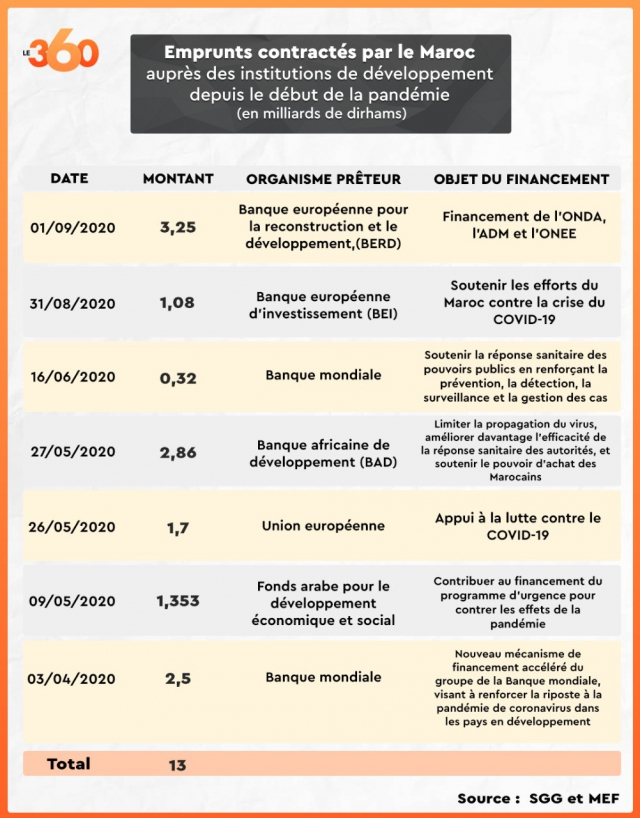 Les actualités de la BRVM en Flux RSS
Les actualités de la BRVM en Flux RSS
Nous agrégeons les sources d’informations financières spécifiques Régionales et Internationales. Info Générale, Economique, Marchés Forex-Comodities- Actions-Obligataires-Taux, Vieille règlementaire etc.
Enjoy a simplified experience
Find all the economic and financial information on our Orishas Direct application to download on Play StoreSince the beginning of the pandemic, Morocco has multiplied foreign currency borrowing from development banks, whether international or regional. The government has already borrowed 13 billion dirhams from major donor partners. Explanations.
To contain the spread of Covid-19 and mitigate its economic and social consequences, Morocco needs funds, a lot of funds. In this sense, the government has chosen to resort to massive debt to finance its program to fight against the coronavirus, and to compensate for the shock on foreign exchange inflows.
The situation of Morocco's international reserves is expected to decline significantly, due to the impact of the crisis on several foreign exchange supplying sectors, in particular the tourism sector, Foreign Direct Investment (FDI) and export sectors, in addition to remittances from Moroccans living abroad.
As of May 8, 2020, Mohamed Benchaâboun, Minister of Economy and Finance, has given himself the means to use more foreign currency financing, by having Parliament adopt Bill 26.20 approving the decree-law on exceeding the ceiling on external loans.
This crucial decree-law authorizes the government to exceed the ceiling of external financing of 31 billion dirhams compared to what was set in the finance law for the 2020 fiscal year. Objective: to insure its foreign currency borrowings, whether through loans on the international market, or from the Kingdom's bilateral partners or donors. "A sufficient level of currency is a guarantee of sovereignty," said Mohamed Benchaâboun.
While waiting for the international exit scheduled for this month of September, which should raise nearly $ 2 billion, the government is multiplying foreign currency borrowing from development banks, whether international or regional.
As such, the Kingdom's treasurer has, from the beginning of the crisis, launched consultations with the main lenders, whether bilateral or multilateral, such as the World Bank, the African Development Bank (AfDB), Arab and Islamic funds and the European Investment Bank (EIB), to determine the additional amounts that can be mobilized beyond those that were programmed before the pandemic.
It must be said that Morocco has always been a good customer of these institutions, a developing country, solvent, and repaying. He therefore had no trouble borrowing the trifle of 13 billion dirhams from the main donor partners. These funds are entirely dedicated to the fight against the spread of the coronavirus and to further improve the effectiveness of the authorities' health response.
In the infographic below, loans granted for reasons other than the fight against the pandemic were not taken into account, as is the case for Germany's €700 million loan to Morocco contracted last July. This loan, as a reminder, was intended to support Morocco in its dynamics of the reforms undertaken, particularly in financial matters, improving the business and investment climate, and strengthening advanced regionalization.
In addition, $3 billion was drawn in early April from the International Monetary Fund's (IMF) Precautionary and Liquidity Line (LPL). Recall that the draw on this liquidity line is made available to Bank Al-Maghrib and allocated mainly to the financing of the balance of payments and will not impact the public debt.

Public debt soars
To cope with this unprecedented crisis, Morocco is borrowing at full speed, even if it means significantly deteriorating the balance of its public finances. At the rate things are going, the State's debt indicators will rise in a dizzying way, especially since the State's tax revenues are falling sharply. According to projections by the High Commission for Planning (HCP), the budget deficit is expected to increase in 2020 to nearly 7.4% of GDP, well above the level reached on an annual average between 2011 and 2013, i.e. 6.1% of GDP.
The Treasury's overall debt is expected to worsen by 10 points, from 65% of GDP to nearly 75%. The external component of this debt would increase from 14% of GDP in 2019 to 17.6% in 2020 and 18.6% in 2021, according to the Central Bank.
Worse, global public debt would exceed the threshold of 90% of GDP in 2020, up nearly ten points from a year earlier.
Although such a level of indebtedness is worrying for a country like Morocco, some economists qualify their analysis. For Yasser Tamsamani, a research economist affiliated with the OFCE, the rise in debt ratios (Treasury debt/GDP and public debt/GDP) is also explained by the decline in the denominator of these ratios, namely GDP. "A resumption of growth in 2021 and therefore an increase in GDP, will mechanically improve the country's debt ratios," he said.
Moreover, to stop the haemorrhage, the majority of the world's states are forced to increase their deficits. In a context such as the one we are experiencing, not going into debt is tantamount to making less growth and therefore to accentuating deficits, and entering a vicious circle.
In reality, the rise in debt is not a problem in itself, but it is the usage that is actually that matters, analyzes Yasser Tamsamani. Depending on whether it is used to finance 'dry consumption' or 'productive investment', the spillover effects on the economy and employment will not be the same.
Morocco's recovery plan, which is currently being drawn up, should therefore not be mistaken about the choices that will be made in terms of resource allocation. Otherwise, our economy faces great difficulties.
Vous devez être membre pour ajouter un commentaire.
Vous êtes déjà membre ?
Connectez-vous
Pas encore membre ?
Devenez membre gratuitement
09/01/2026 - Economie/Forex
07/01/2026 - Economie/Forex
07/01/2026 - Economie/Forex
06/01/2026 - Economie/Forex
06/01/2026 - Economie/Forex
05/01/2026 - Economie/Forex
02/01/2026 - Economie/Forex
31/12/2025 - Economie/Forex
29/12/2025 - Economie/Forex

09/01/2026 - Economie/Forex

07/01/2026 - Economie/Forex

07/01/2026 - Economie/Forex
